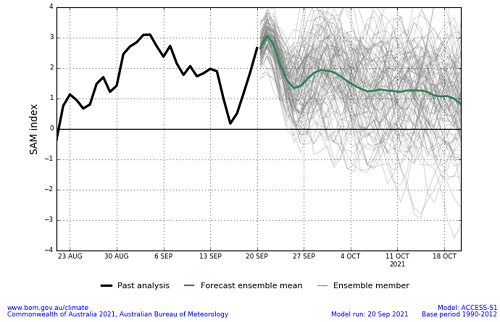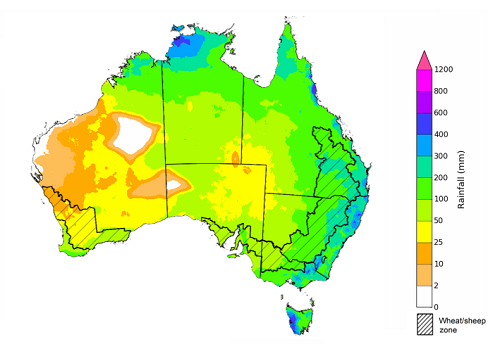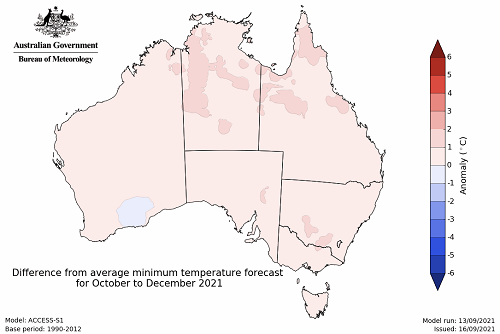Key issues
- During the week ending 22 September 2021, high pressure systems and weak frontal activity across southern Australia resulted in little rainfall across much of the continent. Weak frontal systems brought rainfall to western Tasmania, parts of southern New South Wales, southern Victoria, the far southeast of South Australia and the southwest of Western Australia.
- Cropping regions in northern and eastern Western Australia and parts of South Australia have seen little to no rainfall during September. This coupled with above average temperatures have seen a rapid drying of soil moisture profiles and are likely to lower yield expectations in these regions.
- The negative Indian Ocean Dipole event that was officially declared by the Bureau of Meteorology in July, has weakened though September. However, the pattern of sea surface temperatures in the Indian Ocean remains likely to influence the chances of above-average spring rainfall for much of southern and eastern Australia. The Southern Annular Mode has been positive over the past three weeks and is forecast to remain positive and may continue to have a negative influence on rainfall across southern Australian the coming weeks.
- The outlook for October 2021 indicates that there is a 75% chance of rainfall totals between 10 and 100 millimetres across parts of eastern, south-western and far southern Australia. Rainfall totals in excess of 100 millimetres are expected across alpine regions of New South Wales and Victoria, as well as the west coast of Tasmania.
- The outlook for October to December suggests there is a 75% chance of rainfall totals between 50 and 200 millimetres across much of New South Wales, Queensland, Victoria, the Northern Territory and Tasmania, as well as parts of South Australia and the far south and north of Western Australia. Rainfall totals in excess of 300 millimetres are likely across parts of alpine and coastal regions of New South Wales and Victoria, as well as parts of Queensland, the north of the Northern Territory and western Tasmania.
- High pressure systems are likely to bring clear skies and dry conditions across much of Australia over the next eight days. Parts of southern Australia are expected to receive rainfall as a low-pressure system moves across the country towards the end of next week. Given the rapid drying of soil moisture profile in South Australia, and northern and eastern Western Australia, further rainfall will be required in coming weeks to halt the recent decline in yield prospects particularly across parts of Western Australia.
- Water storage in the Murray–Darling Basin (MDB) increased by 77 gigalitres (GL) between 15 September 2021 and 22 September 2021. The current volume of water held in storage is 21,329 GL, which represents 84% of total capacity. This is 48% or 6,953 GL more than at the same time last year.
- Allocation prices in the Victorian Murray below the Barmah Choke increased from $129 per ML on 10 September 2021 to $139 per ML on 17 September 2021. Prices are lower in the Goulburn-Broken, Murrumbidgee, and regions above the Barmah choke due to the binding of the Goulburn intervalley trade limit, Murrumbidgee export limit, and Barmah choke trade constraint.
Climate
[expand all]
Rainfall this week
During the week ending 22 September 2021, high pressure systems and weak frontal activity across southern Australia resulted in little rainfall across much of the continent. Weak frontal systems brought rainfall to western Tasmania, parts of southern New South Wales, southern Victoria, the far southeast of South Australia and the southwest of Western Australia. Isolated thunderstorms developed near a surface trough and produced moderate falls over parts of central Australia.
Rainfall totals of between 10 and 50 millimetres were recorded across southern ranges of New South Wales, southern and eastern Victoria, the far southwest of Western Australia, much of Tasmania and the far southeast of South Australia. Rainfall totals in excess of 50 millimetres were recorded across alpine regions of New South Wales and Victoria, and western Tasmania.
In cropping regions, rainfall totals of between 5 and 15 millimetres were recorded across parts of southern New South Wales, Victoria and Western Australia. Little to no rainfall was recorded in remaining cropping regions in New South Wales, Victoria and Western Australia as well as most cropping regions in Queensland and South Australia.
Soil moisture levels have been average to above average across most cropping regions which likely supported ongoing crop development over the past week. However, cropping regions in northern and eastern Western Australia and parts of South Australia have seen little to no rainfall during September. This coupled with above average temperatures have seen a rapid drying of soil moisture profiles and are likely to lower yield expectations in these regions.
Rainfall for the week ending 23 September 2021
©Commonwealth of Australia 2021, Australian Bureau of Meteorology - Issued: 22/09/2021
Note: The rainfall analyses and associated maps utilise data contained in the Bureau of Meteorology climate database, the Australian Data Archive for Meteorology (ADAM). The analyses are initially produced automatically from real-time data with limited quality control. They are intended to provide a general overview of rainfall across Australia as quickly as possible after the observations are received. For further information go to http://www.bom.gov.au/climate/rainfall/
Climate Drivers
Throughout spring the climate drivers with the largest potential impact on Australia’s climate patterns are the El Niño–Southern Oscillation (ENSO), the Indian Ocean Dipole (IOD) and the Southern Annular Mode (SAM). These climate drivers will likely influence the final yield prospects for Australia’s winter cropping season, pasture growth rates during this peak growth period and planting condition for summer crops.
A negative IOD event that was officially declared by the Bureau of Meteorology in July, has weakened though September, with IOD values at marginal negative IOD levels. However, the pattern of sea surface temperatures in the Indian Ocean remains likely to influence Australian rainfall over the coming months. The SAM index has been positive over the past three weeks and is forecast to remain positive for several weeks to come. This is supported by a strengthened polar vortex over Antarctica. The positive SAM has likely contributed to the dry conditions seen across parts of southern Australia during September.
Oceanic and atmospheric indicators show ENSO conditions remain neutral. However, strengthening model outlooks and recent cooling in the tropical Pacific Ocean have raised the chance of a La Niña forming in 2021. Most international climate models surveyed by the Bureau of Meteorology indicate central Pacific sea surface temperatures are likely to cool over the coming months, with three of the seven models suggesting the cooling will be sufficient, and sustained for long enough, to meet minimum La Niña event criteria. The remaining models predict neutral ENSO conditions to persist through to early 2022.
Sea surface temperature (SSTs) anomalies have been close to average across the tropical Pacific Ocean over the previous week, with small areas of slightly cooler than average SSTs in the central to eastern equatorial Pacific. Warm anomalies in the western Pacific have decreased slightly, including waters near the Maritime Continent and close to Australia.
Warm sea surface temperature anomalies have weakened slightly near Western Australia and Indonesia. Meanwhile, sea surface temperatures in the western Indian Ocean have cooled slightly over the past week. The continuation of warm anomalies in the eastern Indian Ocean and the ocean surrounding Australia reflect the ongoing negative IOD event.
Difference from average sea surface temperature observations 6 September to 12 September 2021
As at 12 September, the Indian Ocean Dipole (IOD) weekly value was -0.37°C, which would be considered a neutral IOD value and is not forecast to return below the negative threshold of (-0.4°C) during the remainder of spring. This sea surface temperature pattern increases the chance of above average rainfall for southern and eastern Australia and the far north during winter and spring and is typically associated with an early onset of northern rainfall. It also increases the chances of below average maximum temperatures in southern Australia, while increasing the chances of above average minimum and maximum temperatures in northern Australia.
Monthly sea surface temperature anomalies for IOD region
The Southern Annular Mode (SAM) is currently positive and expected to remain positive for the coming weeks. The SAM refers to the north-south shift of the band of rain-bearing westerly winds and weather systems in the Southern Ocean compared to the usual position. When SAM is positive during winter, the band of westerly winds is further south than normal. A negative SAM in winter is associated with increased rainfall for northern New South Wales, southern Queensland and southern parts of South Australia and Western Australia. It is also associated with decreased rainfall for much of Victoria, the west of Western Australia and Tasmania.
Southern Annular Mode (SAM) daily index
National Climate Outlook
These climate outlooks are generated by ACCESS–S (Australian Community Climate Earth-System Simulator–Seasonal). ACCESS–S is the Bureau of Meteorology's dynamical (physics-based) weather and climate model used for monthly, seasonal and longer-lead climate outlooks.
For further information, go to http://www.bom.gov.au/climate/ahead/about/
The Bureau of Meteorology’s latest rainfall outlook indicated wetter than average conditions are expected for much of eastern Australia and average rainfall is expected for Western Australia during October. The wetter than average conditions expected for eastern cropping regions reaffirms the positive production outlook for Australia’s 2021 winter cropping season and will support the establishment of summer crops. The ACCESS-S climate model suggests there is close to a 70% chance of exceeding average October rainfall totals across much of eastern and central Australia.
The outlook for October 2021 indicates that there is a 75% chance of rainfall totals between 10 and 100 millimetres across eastern, central, south-western and far southern Australia. Rainfall totals in excess of 100 millimetres are expected across alpine regions of New South Wales and Victoria, as well as the west coast of Tasmania.
Across cropping regions there is a 75% chance of rainfall totals of between 5 and 10 millimetres in the north of Western Australia. There is a 75% chance of rainfall totals between 10 and 50 millimetres for New South Wales, Queensland, Victoria, South Australia and remaining parts of Western Australia.
The dryer than average conditions expected in Western Australian cropping regions are unlikely to see an improvement in current yield prospects but will aid harvesting of winter crops which are likely to commence in October. Meanwhile, the wetter than average conditions in eastern states will support yield potentials for late sown winter crops and support the planting of dryland summer crops
Rainfall totals that have a 75% chance of occurring October 2021
©Commonwealth of Australia 2021, Australian Bureau of Meteorology - Issued: 16/09/202
The rainfall outlook for October to December suggests there is a greater than 75% chance of exceeding average rainfall across much of New South Wales, central and southern Queensland, Victoria, South Australia, parts of the Northern Territory and eastern Tasmania. There is less than a 40% chance of exceeding average rainfall in south-western Tasmania, but no strong tendency toward above or below average rainfall across the much of Western Australia (Bureau of Meteorology ‘National Climate Outlook’, 16 September 2021).
Bureau of Meteorology rainfall outlooks for October to December have greater than 55% past accuracy across most of Australia. Outlook accuracy is greater than 65% for parts of New South Wales, Queensland, Victoria, South Australia, Western Australia, the Northern Territory and Tasmania. On the other hand, there is low past accuracy in western and central Western Australia and southern Tasmania.
Chance of exceeding the median rainfall October to December 2021
©Commonwealth of Australia 2021, Australian Bureau of Meteorology - Issued: 16/09/202
The outlook for October to December suggests there is a 75% chance of rainfall totals between 50 and 200 millimetres across most of New South Wales, Queensland, Victoria, the Northern Territory and Tasmania, as well as parts of South Australia and the far south and north of Western Australia. Rainfall totals in excess of 300 millimetres are likely across parts of alpine and coastal regions of New South Wales and Victoria, as well as parts of Queensland, the north of the Northern Territory and western Tasmania.
Across cropping regions, there is a 75% chance of receiving between 50 and 200 millimetres in New South Wales, Queensland, Victoria, South Australia and southern parts of Western Australia. Rainfall totals in excess of 200 millimetres are forecast for parts of central Queensland and north-eastern New South Wales cropping regions. Totals of less than 50 millimetres are expected across central and northern cropping areas of Western Australia.
These rainfall totals are slightly below average for this three-month period across some Western Australian cropping regions, and average to above aveage for cropping regions of New South Wales, Queensland and Victoria. The expected conditions for eastern states may limit field access and slowdown the winter crop harvest, as well as increasing the potential of grain quality issues. Close to average rainfall totals for Queensland and northern New South Wales will support the germination and establishment of summer sown crops.
Rainfall totals that have a 75% chance of occurring October to December 2021
©Commonwealth of Australia 2021, Australian Bureau of Meteorology - Issued: 16/09/202
The temperature outlook for October to December 2021 indicates that maximum temperatures across most of Australia are likely to be close to the 1990-2012 average (- 1°C to 1°C). Minimum temperatures are expected to be slightly above average for parts of northern Queensland, the Northern Territory, southern New South Wales and the east of South Australia (Bureau of Meteorology ‘National Climate Outlook’, 16 September 2021).
Predicted maximum temperature anomaly for October to December 2021
Predicted minimum temperature anomaly for October to December 2021
Rainfall forecast for the next eight days
High pressure systems are likely to bring clear skies and dry conditions across much of Australia over the next eight days. Parts of southern Australia are expected to receive rainfall as a low-pressure system moves across the country towards the end of next week.
Rainfall totals of between 10 and 50 millimetres are forecast for much of eastern New South Wales, southern and central Victoria, north-east Queensland, the south-west of Western Australia and Tasmania. Rainfall in excess of 50 millimetres is expected in parts of western Tasmania.
In Australian cropping regions, rainfall totals of between 10 and 25 millimetres are expected across much of New South Wales, eastern Victoria and the far southwest of Western Australia. Lower rainfall totals of between 5 and 10 millimetres are expected across parts of southern Queensland, western Victoria, and central Western Australia. Little to no rainfall is forecast for remaining areas in Queensland, northern and eastern Western Australia and much of South Australia during the next 8-days.
Soil moisture levels remain average to above average across most cropping regions in New South Wales, Victoria, southern Queensland and southern Western Australia for this time of year. Despite the lack of rainfall over the past week, and the expectation of another dry week ahead in Queensland and parts of Victoria, winter crop development is expected to continue unimpeded in these areas.
However, a lack of rainfall in South Australia, and northern and eastern Western Australia has led to a rapid drying of the soil moisture profile. Further rainfall will be required through spring as crops enter stages in which they are most sensitive to water deficiencies (flowering and grain filling) to halt the recent decline in yield prospects particularly across parts of Western Australia. The dry conditions in Queensland are continuing to assist cotton planting, with the forecast of a wet spring/summer to support dryland yield potentials.
Total forecast rainfall (mm) for the period 23 September to 30 September 2021
©Commonwealth of Australia 2021, Australian Bureau of Meteorology - Issued: 23/09/2021
Note: This rainfall forecast is produced from computer models. As the model outputs are not altered by weather forecasters, it is important to check local forecasts and warnings issued by the Bureau of Meteorology.
Water
Water storages, water markets and water allocations - current week
The Tableau dashboard may not meet accessibility requirements. For information about the contents of these dashboards contact ABARES.










